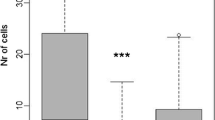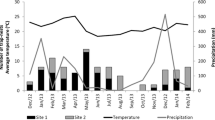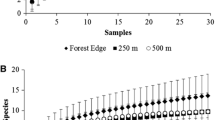Abstract
As most stingless bee species depend on preexisting cavities, principally tree hollows, nesting site availability may represent an important restriction in the structuring of their forest communities. The present study examined the spatial dynamics of stingless bee communities in an area of Atlantic Forest by evaluating their swarming to trap-nests. The field work was performed in the Michelin Ecological Reserve (MER) on the southeastern coast of the state of Bahia, Brazil. Seven hundred and twenty trap-nests were distributed within two forest habitats in advanced and initial stages of regeneration. The trap-nests were monitored between September 2009 and March 2011. Twenty-five trap-nests were occupied by five bee species, resulting in a capture ratio of 0.035 swarms/trap (approximately 0.14 swarms/ha), corresponding to 10 swarms/year (0.056 swarms/ha/year). According to previous study at MER, the most abundant species in natural nests were also the most common in trap-nests in the two forest habitats examined, with the exception of Melipona scutellaris Latreille. Swarms of higher numbers of species were captured in initial regeneration stage forests than in advanced regeneration stage areas, and differences in species compositions were significant between both habitats (p = 0.03); these apparent differences were not consistent, however, when considering richness (p = 0.14) and total abundance (p = 0.08). The present study suggests the existence of a minimum cavity size threshold of approximately 1 L for most local species of stingless bees and sustains the hypothesis of a mass effect of Tetragonisca angustula Latreille populations from surrounding disturbed habitats on the MER forest community in terms of propagule (swarm) pressure. Examining swarm densities with trap-nests can be a promising technique for comparative analyses of the carrying capacities of forest habitats for stingless bee colonies, as long as size thresholds of cavities for nesting are taken into consideration.



Similar content being viewed by others
References
Anderson MJ (2005) PERMANOVA: permutational multivariate analysis of variance—A computer program. Departament of Statistics, University of Auckland, Auckland. http://www.stat.auckland.ac.nz/~mja/Programs.htm/. Accessed 25 Nov 2012
Araújo ED, Costa M, Chaud-Netto J, Fowler H (2004) Body size and flight distance in stingless bees (Hymenoptera: Meliponini): inference of flight range and possible ecological implications. Braz J Biol 64(3B):563–568
Batista MA, Ramalho M, Soares AEE (2003) Nesting sites and abundance of Meliponini (Hymenoptera: Apidae) in heterogeneous habitats of the Atlantic rain forest, Bahia, Brazil. Lundiana 4:19–23
Biesmeijer JC, Slaa EJ (2006) The structure of eusocial bee assemblages in Brazil. Apidologie 37:240–258
Biesmeijer JC, Slaa EJ, Castro MS, Viana BF, Kleinert AMP, Imperatriz-Fonseca VL (2005) Connectance of Brazilian social bee-food plant networks is influenced by habitat, but not by latitude, altitude or network size. Biota Neotrop 5:1–10
Bray RJ, Curtis JT (1957) An ordination of the upland forest communities of southern Wisconsin. Ecol Monogr 27:325–349
Bravo F (1993) Descrição dos ninhos de Parapartamona zonata (Smith,1854) e Parapartamona brevipilosa (Schwarz, 1948) (Hymenoptera, Apidae, Meliponinie) coletados nos Andes Equatorianos. Rev Bras Entomol 37(4):779–785
Brown JC, Albrecht C (2001) The effect of tropical deforestation on stingless bees of the genus Melipona (Insecta: Hymenoptera: Apidae: Meliponini) in central Rondonia, Brazil. J Biogeogr 28:623–634
CEI-Conder Bahia (1993) Informações básicas dos municípios baianos: Litoral Sul. Salvador, p 1100
Eltz T, Brühl CA, Kaars SV, Linsenmair KE (2002) Determinants of stingless bee nest density in lowland dipterocarp forests of Sabah, Malaysia. Oecologia 131:27–34
Hubbell SP, Johnson LK (1977) Competition and nest spacing in a tropical stingless bee community. Ecology 58:950–963
Inoue T, Sakagami SF, Salmah S, Nukmal N (1984) Discovery of successful absconding in the stingless bee Trigona (Tetragonula) laeviceps. J Apic Res 23:136–142
Kleinert AMP (2006) Demografia de ninhos de meliponíneos em biomas neotropicais. Thesis, Universidade de São Paulo, São Paulo, p 93
Kleinert AMP, Ramalho M, Laurino MC, Ribeiro MF, Impetratriz-Fonseca VL (2009) Abelhas sociais (Meliponini, Apinini, Bombini). In: Panizzi AR, Parra JRP (eds) Bioecologia e Nutrição de Insetos. Base para o Manejo Integrado de Pragas. Embrapa Informação Tecnológica, Brasilia, pp 371–424
Köppen W (1948) Climatología: Con un estudio de los climas de la Tierra. Fondo de Cultura Econômica, México, p 479
Martins CF, Cortopassi-Laurino M, Koedam D, Imperatriz-Fonseca VL (2004) Espécies Arbóreas Utilizadas para Nidificação por Abelhas sem Ferrão na Caatinga (Seridó, PB João Camara, RN). Biota Neotrop 4:1–8
Michener CD (1946) Notes on the habits of some Panamanian stingless bees (Hymenoptera, Apidae). J N Y Entomol Soc 3:179–197
Michener CD (2000) The bees of the world. Johns Hopkins University, Baltimore, 913 p
Morato EF, Campos LAO (2000) Efeitos da fragmentação florestal sobre vespas e abelhas solitárias em uma área da Amazônia Central. Rev Bras Zool 17:429–444
Nogueira-Neto P (1997) Vida e criação de abelhas indígenas sem ferrão. Nogueirapis, São Paulo, p 445
Oliveira RC, Menezes C, Silva RAO, Soares AEE, Imperatriz-Fonseca VL (2013) Trap-nests for stingless bees (Hymenoptera, Meliponini). Apidologie 44:29–37
Ramalho M (2004) Stingless bees and mass flowering trees in the canopy of Atlantic Forest: a tight relationship. Acta Bot Bras 18:37–47
Roubik DW (1979) Nest and colony characteristics of stingless bees from French Guiana. J Kansas Entomol Soc 52:443–470
Roubik DW (2006) Stingless bee nesting biology. Apidologie 37:124–143
Sakagami SF (1982) Stingless bees. In: Hermann HR (ed) Social insects. Academic, New York, pp 361–423
Samejima H, Marzuki M, Nagamitsu T, Nakasizuka T (2004) The effects of human disturbance on a stingless bee community in a tropical rainforest. Biol Conserv 120(4):577–587
Silva MD, Ramauro M, Monteiro D (2013) Diversity and habitat use by stingless bees (Apidae) in the Brazilian Atlantic Forest. Apidologie 44:699–707
Slaa EJ (2006) Population dynamics of a stingless bee community in the seasonal dry lowlands of Costa Rica. Insect Soc 53:70–79
Starr CK, Sakagami SF (1987) An extraordinary concentration of stingless bee colonies in the Philippines, with notes on nest structure (Hymenoptera: Apidae: Trigona spp.). Insect Soc 34:96–107
Taura HM, Laroca S (1991) Abelhas altamente sociais (Apidae) de uma área restrita em Curitiba (Brasil): Distribuição dos ninhos e abundância relativa. Acta Biol Parana 20(1, 2, 3, 4):85–101
Van Veen JW, Arce HGA (1999) Nest and colony characteristics of log-hived Melipona beecheii (Apidae: Meliponinie). J Apic Res 38(1–2):43–48
Wille A, Michener CD (1973) The nest architecture of stingless bees with special reference to those of Costa Rica (Hymenoptera: Apidae). Rev Biol Trop 21:3–278
Acknowledgments
The authors would like to thank Dr. Favízia F. de Oliveira at the Laboratory of Insect Bionomy, Biogeography and Systematics (BIOSIS) at the Biology Institute (IBIO) of the Federal University of Bahia for identifying the specimens and the Michelin Ecological Reserve for logistic support; CAPES for awarding a doctoral grant to the first author; CNPq (Process nos. 481113/2004-5, 478271/2008, and 474313/2011-5); and FAPESB (Process APR no. 0114/2006) for supporting this research.
Author information
Authors and Affiliations
Corresponding author
Additional information
Edited by Fernando B Noll – UNESP
Rights and permissions
About this article
Cite this article
Silva, M.D., Ramalho, M. & Monteiro, D. Communities of Social Bees (Apidae: Meliponini) in Trap-Nests: the Spatial Dynamics of Reproduction in an Area of Atlantic Forest. Neotrop Entomol 43, 307–313 (2014). https://doi.org/10.1007/s13744-014-0219-8
Received:
Accepted:
Published:
Issue Date:
DOI: https://doi.org/10.1007/s13744-014-0219-8




